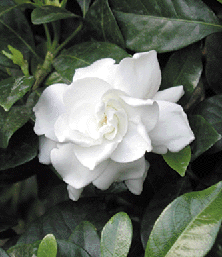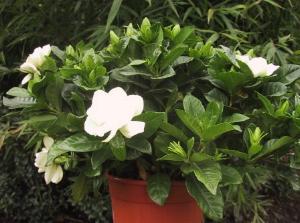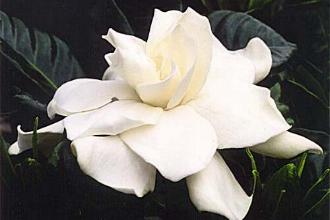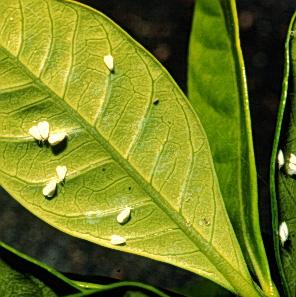|
Plants for your home
(By Mary Efanti)
Gardenia
 Origin and
Description Origin and
Description
A favorite shrub, the gardenia has very fragrant creamy-white flowers and glossy,
dark-green leaves. The genus Gardenia is believed to have been named
after Alexander Garden, a physician in Charleston, South Carolina, during
colonial days. Gardenias are a member of the family Rubiaceae and belong to the genus Gardenia.
There are over 200 species of Gardenias. One species is of primary importance: Gardenia
jasminoides containing many cultivars.Gardenia jasminoides is native
to China although most named cultivars have arisen in cultivation.
Gorgeous, dark to bright green, opposite leaves on a shrub that can grow 6'-8'
with almost equal spread. Leaves are glossy and leathery. Mature shrubs usually
look round, and have a medium texture. Blooms in mid-spring to early summer,
over a fairly long season: this is not a bloom-all-at-once-and-it’s-over
shrub! Flowers are white, turning to creamy yellow as they age, and have a waxy
feel. They have a powerful, sweet fragrance, and can perfume an entire room. Air
currents waft the scent throughout the warm summer garden.
Care
 The best way to have a Gardenia (Gardenia jasminoides) survive in the
average home is to start one from a cutting. As it grows, it will become
acclimatized to the environmental conditions of that room. Gardenias detest
being moved from the controlled temperature and humid environment of a
greenhouse to the much warmer and drier environment of most homes. If you want a
Gardenia to survive in your home, you will have to create an environment just
like the one where it grows naturally (southern China and Japan) with warm days,
cool nights and moist, humid conditions. The best way to have a Gardenia (Gardenia jasminoides) survive in the
average home is to start one from a cutting. As it grows, it will become
acclimatized to the environmental conditions of that room. Gardenias detest
being moved from the controlled temperature and humid environment of a
greenhouse to the much warmer and drier environment of most homes. If you want a
Gardenia to survive in your home, you will have to create an environment just
like the one where it grows naturally (southern China and Japan) with warm days,
cool nights and moist, humid conditions.
The plant must have a rich, acid soil (pH of 4.5 - 5.5). A newly purchased
plant will or should have this type of soil. The soil should be porous which
allows water to drain through quickly and yet has the ability to retain moisture.
Prepackaged acid based potting mixes that are prepared especially for gardenias,
camellias and azaleas can be purchased at many garden centers.
Repot the plant in a plastic pot or tub
with good drainage holes. This is the best choice for this plant as we want to keep
the gardenia's soil constantly moist.
Repot the plant every 2 - 3 years, unless crowded roots demand earlier repotting
of the plant.
 Watering Watering
Watering during dry periods is
necessary for healthy gardenias. Moist soil is essential for successful
gardenias. Watering is important because it largely controls the number of
flower buds that remain on a plant to maturity. If water stress occurs in a
heavily budded plant, many buds will fall before opening. Therefore, while the
plant is in bud, large variations in soil moisture should be avoided.
The soil must always be 'slightly damp'. Its surface should always feel moist when it is
touched. This calls for
frequent watering and that's why the soil has to have good porosity (drainage)
so it never becomes waterlogged. Water the plant with soft, tepid water from the
top of the pot. Do not let the plant stand in water. If the gardenia is over-watered,
both leaves and flower buds will drop, and the roots will rot. Under-watering (allowing
the soil to dry out) can also lead to leaf drop, but this is a slower process
and the leaves may fall a week or two after the plant has been re-watered.
Sometimes, depending on the
water supply, tap water can eventually change the pH of a soil. In other words,
the soil will become alkaline instead of acidic. A plant disorder known as
chlorosis can then affect the gardenia. The leaves will become pale colored (almost
yellow) and have dark green veins. If this happens, the problem can be corrected
by adding iron sulfate or iron chelate to the potting soil. Most garden centers
sell these products. The usual mix is 1/2 ounce of either kind added to one
gallon of tepid water. Water the plant with this mixture once or twice a week
for a month or until the plant is back to normal health.
Temperature
Daytime temperatures for the gardenia should be between 70-72 degrees F.
Night temperatures are much more critical if you want the plant to bloom. If
temperatures are allowed to rise higher than 60 - 62 degrees F. for even a few
nights in a row, the plant will not set any new flower buds. To further
complicate matters, a gardenia must not have any sudden changes in temperature,
or be exposed to warm or cold drafts. Any sudden environmental changes can cause
the buds to drop.
Light
Like all flowering plants, the gardenia needs bright light in order to
bloom,
but not direct sunlight, especially in summer. Direct sunlight creates dry heat
which is not good for humid loving plants. So, the best spot in the home is a
south facing window with a light shading curtain between the plant and the
window. This, however, is not enough. If cloudy weather persists for 3 or 4 days,
flower buds may drop or the plant may not produce buds at all. To prevent this
from happening, the plant should have artificial light provided during these
dull days. Fluorescent light fixtures can be purchased that are designed
especially for growing houseplants.
 Humidity Humidity
The plant will not tolerate dry air (low humidity
levels). Place the pot on a
large humidifying tray and always keep water in it. The pot must not sit in the
water. If the air becomes very dry in the room, flower buds will drop. Misting
the foliage is beneficial, although at times the plant seems to resent having
its buds misted. Humid air will also help prevent the possibility of a red
spider mite infestation.
Fertilization
Fertilize the plant once a month while the plant is actively growing with a
water soluble acid fertilizer formulated for acid loving plants (like gardenias).
These formulas are less likely to change the soils pH. Follow directions on the
labels for proper amounts. Another option is to use liquid fish emulsion
fertilizer and apply it every two weeks. If the plant develops pale green
colored leaves, a shortage of nitrogen fertilizer is probably the cause. Do not
confuse this with chlorosis previously mentioned where the leaves are pale
colored with dark green veins.
Insects
Many insect pests attack gardenias and can be troublesome unless proper control
methods are used. The most injurious insects include scales, aphids, spider
mites, thrips and whiteflies. Scale insects include cottony cushion, soft brown scale and
others. These
insects attach themselves to host plants after hatching and give stems or leaves
a lumpy appearance. Scale insects are difficult to control especially as they
mature. Spider mites can cause considerable damage especially during hot, dry
periods.
These small pests feed primarily on the underside of the foliage, causing
colorless or whitish spots. Therefore, considerable injury usually has occurred
when the homeowner notices the damage.
Insects damage unopened buds, causing them to drop. Thrips and aphids are most
troublesome. Usually pear-shaped aphids are visible but tiny thrips can go
undetected until they cause considerable damage.
In the Garden
To grow the plant outside, choose a semi-sunny location in which the plant
will have some shade from the hot afternoon sun. It should also have protection
from strong winds. The soil must be well-drained, slightly acid (add peat moss),
and rich in organic matter. Well rotted manure or compost and bonemeal ( apply
at the rate recommended on the container) should be added and thoroughly worked
into the top foot or two of soil. As long as the plant continues to grow and
flower well, additional fertilizer is not necessary. Otherwise, use the same
fertilizer as you would for the houseplant and drench the soil around the plant.
Keep the soil constantly moist. A 2-3 inch layer of organic matter placed over
the soil will help keep the soil moist. Keep the mulch a few inches back from
the base of the plant.
The houseplant grown gardenia may also be grown outside in the
summer. Simply
transplant it into a larger pot in the spring to allow for the summers growth,
and then bury it outside in the soil giving it the same location and care as the
outside plant above.
Mary Efanti
[email protected]
|
